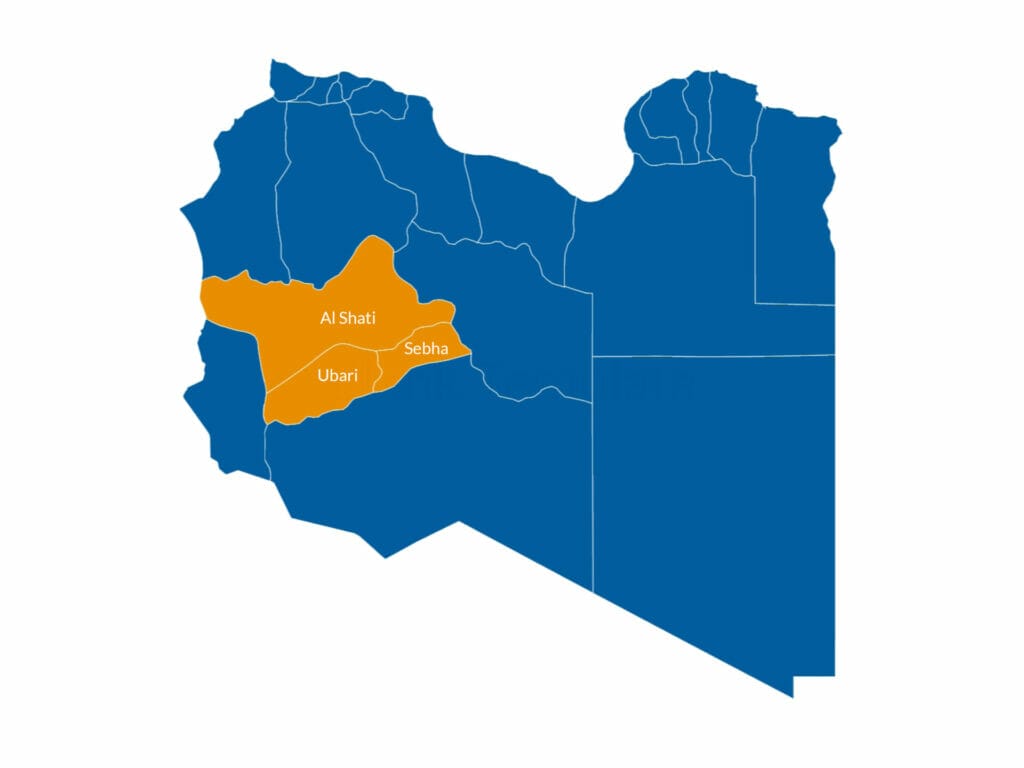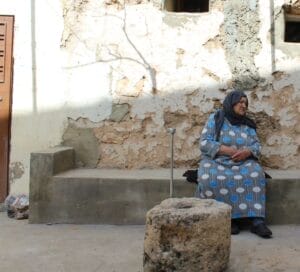
Health, education and livelihood are the main sectors at risk. Insecurity and political instability, the main root causes of internal displacement.
Denial of access to services and providers and forced movements of population. These are the two high protection risks identified in Southern Libya, as a result of the protection analysis conducted by We World - GVC in collaboration with MIGRACE in the sub-districts of Ubari, Al Shati and Sebha. The analysis targeted six communities, composed of Libyans, internal displaced people (IDPs) and migrants from Sub-Saharan countries, for a total of 157 participants, 53% of whom women and 47% men. The main results of the data collection, carried out through multi-sectoral assessments between December 2021 and January 2022, are outlined in the Protection Analysis Report 2022 (full report below).

Context - The targeted area for this analysis can be described as a complex reality where different tribes and ethnic groups coexist, the power is distributed between formal and informal authorities, the division of roles within local communities is based on gender, the rural economy is centered on agriculture. The context is also characterized by a high level of insecurity. Due to different root causes, such as conflict, governmental instability, gap between local and national authorities, lack of investments, limited capacities of the public sector, the access to basic services is limited, this resulting in protection risks, since the right of people to live a dignified life is not fully guaranteed.
First protection risk, denial of access to services and providers - 58% of assessed communities state there are no stakeholders present in the area to address their basic needs. The main sectors concerned are health, education and livelihood.
Health - In terms of access to public health, 60% of the assessed communities are facing difficulties, due to key barriers such as long distance (75%): from 45 to 60 minutes to reach the nearest public hospital; from 15 to 30 minutes to reach out the first health center facility. Even when the access to facilities is possible, the infrastructures are weak, due to poor electric system and scarce medical and human resources. In this context, 54% of assessed communities is suffering from chronic diseases; 18% is presenting a critical medical condition.
Education - The challenging access to primary and secondary schools is mainly related to lack of affordable means of transportations (17%), weak infrastructures (17%), long distances (14%). As a consequence, children dropout from school, at the age of around 13-15 years old.
Livelihood - Increased prices, lack of food supplies, low income, lack of job opportunities have been identified as the main threats that expose the local communities to livelihood issues: 67% of the assessed communities are running out of food because of the lack of money and resources; 67% received an eviction notice in the six months preceding this analysis.
FOCUS
Persons with disabilities (PwDs) are the most impacted vulnerable group in Health and Education. On the one hand, health facilities lack equipment and rehabilitation and do not provide specific health services. On the other, schools are not inclusive and well equipped to facilitate the access of PwDs.
Women within the assessed local communities are more exposed to early school dropouts than men, have more difficulties in accessing the job market and are more involved in informal economy. If they can find a job in the public sector, they work mainly as teachers and nurses.
How are these threats affecting the population? Due to the negative impact of all these threats on the population, the report highlights the phenomena of internal migration from rural areas to Sebha city (men moving to find a job in transport sector) and to Tripoli (men and women). Almost 70% of assessed communities have mentioned lack of access to health, education and livelihood as a reason for leaving.
Second protection risk, forced movement of population - 80% of IDPs left Murzuq and other areas due to tribal or political conflict and lack of security in the area, with no possibility to return, even after years of displacement. When IDPs arrive in Ubari, Sebha, Al Shati, not only this movement has an impact on the hosting communities in terms of increase of demography, social tensions and pressure on resources available, but also internal displaced people can be exposed to the same protection risk affecting the hosting communities in that area. This is the reason why, after being forced to leave their homes, IDPs can be involved in a new migration, a secondary movement driven by a lack of access to services and providers in the area.
Coping strategies and capacities - In this context, internal migration and secondary movement of IDPs can mitigate the protection threats faced by vulnerable groups. Among the capacities that can mitigate or in some cases amplify risks and threats we can find: the social cohesion linked to tribe dynamics, the conflict prevention and resolution through the community-based mechanism, the presence of international and national humanitarian actors. However, humanitarian assistance in the area remains limited with little access by the communities, especially by elderly and PwDs.
The Protection Analysis Report 2022 on Southern Libya is based on the Community Protection Approach (Multi-sectorial Questionnaires transformed into Integrated Protection System of Indicators that provide a quantitative protection-focused descriptive analysis) and on the Protection Analytical Framework. The objective of the analysis is to have a first understanding of the limitations and opportunities to obtain more relevant protection monitoring data in the field and the definition of protection response strategies tailored to the context. The protection risk analysis process was conducted under the project “Emergency program in Libya to improve basic Health and Protection services for the most vulnerable population” financed by the Italian Agency for Development Cooperation (AICS).


